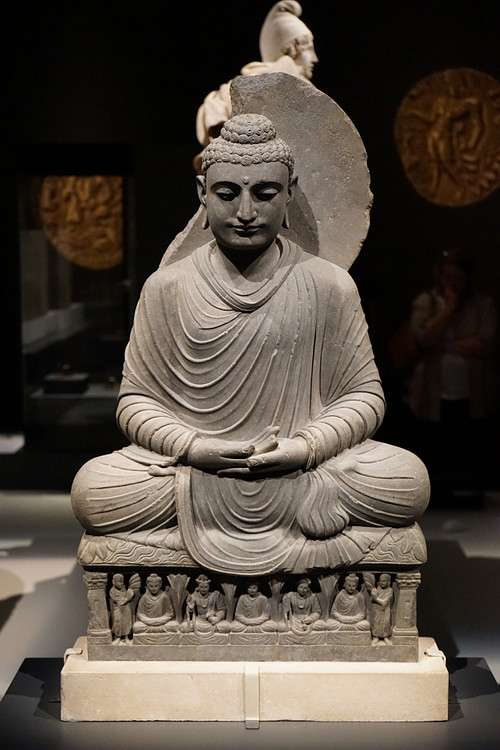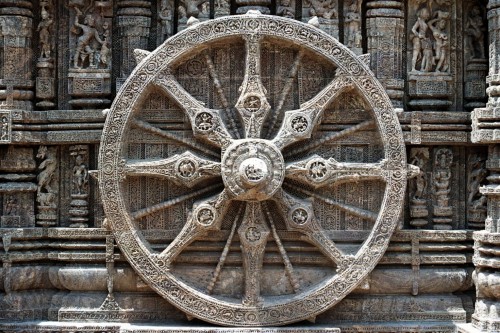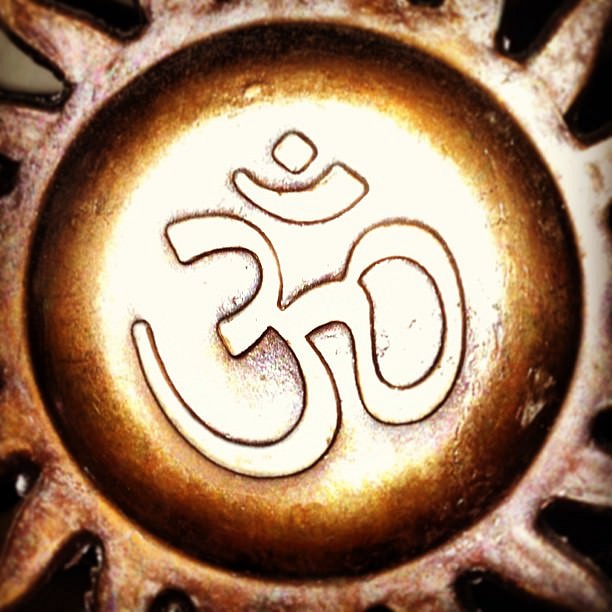Four Noble Truths › Brahmanism » Ancient origins
Articles and Definitions › Contents
- Four Noble Truths › Antique Origins
- Brahmanism › Antique Origins
Ancient civilizations › Historical and archaeological sites
Four Noble Truths › Antique Origins
Definition and Origins

The Four Truths (Skt: catvari aryasatyani ; Pail: cattari ariyasaccani ), also commonly known as 'The Four Noble Truths ' explain the basic orientation of Buddhism. They are the truths understood by the 'worthy ones,' those who have attained enlightenment or nirvana. The four truths are dukkha (the truth of suffering); the arising of dukkha (the causes of suffering);the stopping of dukkha (the end of suffering); and the path leading to the stopping of dukkha (the path to freedom from suffering).
DUKKHA (SUFFERING)
Dukkha is defined in more detail as the human tendency to cling to or crave impermanent states or objects which keep us caught in samsara, the endless cycle of repeated birth, suffering and dying. It is thought that the Buddha taught the Four Truths in the very first teaching after he had attained enlightenment as recorded long after his physical death in the Dhammacakkappavattana Sutra ('The Discourse that Sets Turning the Wheel of Truth'), but this is still in dispute. They were recognised as perhaps the most important teachings of the Buddha Shakyamuni only at the time the commentaries were written, c. 5th century CE. On his deathbed, he also emphasised their importance:
Through not seeing the Four Noble truths
Long was the weary path from birth to birth.
When these are known, removed is rebirth's cause,
The root of sorrow plucked; then ends rebirth.( Mahaparinirvana Sutra )
Understanding or accepting transmigration (reincarnation-captivity in samsara ) and karma (all freely chosen and intended moral acts inevitably entail consequences) are a requirement of being able to embrace the Four Truths.
All rebirth is due to karma and is impermanent. Short of attaining enlightenment, in each rebirth one is born and dies, to be reborn elsewhere in accordance with the completely impersonal causal nature of one's own karma.(Williams, Buddhist Thought, 54)
The Four Truths are often best understood using a medical framework: Truth 1 is the diagnosis of an illness or condition; Truth 2 is identifying the underlying causes of it; Truth 3 is its prognosis or outcome; the 4th Truth is its treatment.
Truth 1: The Truth of Suffering
All humans experience surprises, frustrations, betrayals, etc., which lead to unhappiness and suffering. Acknowledging or accepting that we will encounter difficulties in daily life as an inevitable and universal part of life as a human being is the first truth. Within this, there are two types of suffering: a) natural suffering – disasters, wars, infections, etc.; b) self-inflicted suffering – habitual reacting and unnecessary anxiety and regret.
Truth 2: The Causes of Suffering
ALL SUFFERING LIES NOT IN EXTERNAL EVENTS OR CIRCUMSTANCES BUT IN THE WAY WE REACT TO & DEAL WITH THEM, OUR PERCEPTIONS AND INTERPRETATIONS.
All suffering lies not in external events or circumstances but in the way we react to and deal with them, our perceptions and interpretations. Suffering emerges from craving for life to be other than it is, which derives from the 3 poisons: Ignorance (Delusion) of the fact that everything, including the self, is impermanent and interdependent; Desire (Greed) of objects and people who will help us to avoid suffering; Aversion (Anger) to the things we do not want, thinking we can avoid suffering. We can learn to look at each experience as it happens and be prepared for the next.
Truth 3: The End of Suffering
We hold limiting ideas about ourselves, others, and the world, which we need to let go of. We can unlearn everything from our social conditioning and so bring down all barriers or separations.
Truth 4: The Path that Frees us from Suffering
The mind leads us to live in a dualistic way, but if we are aware of and embrace our habits and illusions, we can abandon our expectations about the ways things should be and instead accept the way they are. We can use mindfulness and meditation to examine our views and so get an accurate perspective.
This Truth contains the Eightfold Path leading out of samsara to nirvana. It consists of
- Right View ( samyag - drusti ) – acceptance of the fundamental Buddhist teachings
- Right Resolve ( samyak - samkalpa ) – adopting a positive outlook and a mind free from lust, ill-will, and cruelty
- Right Speech ( samyag -vac ) – using positive and productive speech as opposed to lying, frivolous or harsh speech
- Right Action ( samyak - karmanta ) – keeping the five precepts ( panca - sila ) – refraining from killing, stealing, misconduct, false speech, and taking intoxicants
- Right Livelihood ( samyag -ajiva ) – avoiding professions which harm others such as slavery of prostitution
- Right Effort ( samyag - vyayama ) – directing the mind towards wholesome goals
- Right Mindfulness ( samyak - smrti ) – being aware of what one is thinking, doing, and feeling at all times
- Right Meditation ( samyak -samadhi ) – focusing attention in order to enter meditational states ( dhyanas ).
These eight aspects of the path are often divided into 3 group or skandhas : 3-5 relate to morality; 6-8 to meditation; and 1-2 to insight. This eightfold path is not linear, passing from one stage to the next, but cumulative so that ideally all eight factors are practised simultaneously.

Dharma Wheel
DIFFERENT INTERPRETATIONS
There are numerous different Buddhist schools which have evolved over many centuries in different corners of the world.
Early Indian & Theravada Buddhism (the First Turning of the Wheel of Dharma)
The Buddha transcended physical existence after he died, proclaiming that he was eternally enlightened and essentially non-physical. Accordingly, the Buddha's words had only one meaning, and so the Four Truths are to be understood simultaneously in one moment of insight, not in the four distinct stages. This is liberation or enlightenment itself.
Mahayana (the Second Turning of the Wheel of Dharma)
The Four Truths became gradually less prominent because of the importance of cultivating sunyata (insight/emptiness) and taking the Bodhisattva path (of altruism or serving others).
Vajrayana or Tibetan Buddhism (the Third Turning of the Wheel of Dharma)
The Four Truths are studied from Mahayana commentaries such as Abhisamayalamkara Sutra, and the 4th Truth is presented as five aspects, not eight. These teachings also present 16 characteristics of the Four Truths taken from the sutra, providing the aspirant with greater detail to facilitate the realisation of their goals, such as awareness, achievement, pacification, and deliverance.

Buddhist Illuminated Manuscript, Goryeo Period
Nichiren Buddhism from Japan bases its teachings on the Lotus Sutra, the penultimate teaching of the Buddha. It states that the Four Truths are a provisional teaching which Buddha taught to suit the capacity of people of the time, while the Lotus Sutrais a direct account of Shakyamuni's own enlightenment.
THE FOUR TRUTHS TODAY
Cultivating an awareness of reality allows Buddhists to deal effectively with delusional interpretations and perceptions.Through meditation, this awareness is developed so that they can escape from samsara and take all sentient beings with them. In this way, the habitual view of the human condition can be transformed and deep insight into the meaning of life can be gained.
The fearless have crossed over the river of sorrow. Life unexamined, unobserved, unenlightened, is nothing but a river of sorrow and we are all drowning in it. (Osho,( Dhammapada ; The Way of the Buddha Vol 6. )
Brahmanism › Antique Origins
Definition and Origins

Brahmanism is an ideology and a way of life, originating from the history of the Vedas, often called a philosophy, practised on the basis of specific inferred beliefs. The fundamental and principle belief of Brahmanism defines Brahman and its attributeless element that was first captured by the Rishis who compiled the Vedas. "That which existed before creation, that which constitutes the existent whole, and that into which all creation dissolves is the all-pervading Brahman, and the cycle of creation, sustenance, and destruction of the universe is endless." (Kena Upanishad)
BRAHMAN, THE UNIVERSAL INTELLECT
The Vedic era thrived from 1500 BCE to 500 BCE in northern India on both sides of the Indus river. The Indus valley was civilised by the Aryans – the 'noble' ones – who worshipped nature. The Vedas originally believed in the concept of Sanatana Dharma (eternal order of life) where nature was worshipped with rituals and praise, which supposedly forms a significant part of the Vedas. The Vedas originated the ideology of Brahman, which became the central theme of those following the Vedas and its principles.
That which cannot be expressed by speech, but by which speech is expressed — That alone is known as Brahman and not that which people here worship.That which cannot be apprehended by the mind, but by which, they say, the mind is apprehended — That alone is known as Brahman and not that which people here worship.That which cannot be perceived by the eye, but by which the eye is perceived — That alone is known as Brahman and not that which people here worship.That which cannot he heard by the ear, but by which the hearing is perceived — That alone is known as Brahman and not that which people here worship. (Kena Upanishad)
Brahman as the Ultimate Reality, the Universal Intellect that is endless, without beginning, middle and end is a metaphysical concept which forms the basis of Brahmanism. Brahmanism is considered to be the predecessor of Hinduism. Brahmanism is the central theme and belief of Vedic followers, its thoughts and philosophical concept giving rise to the primary and socio-religious belief and conduct in Hinduism.
Since the inference and perception of Brahman were put forward by the Rishis, the ones who later became staunch followers of Brahmanism, they were considered, according to some, to be of priestly caste and were called Brahmans. They duplicated the ideology through teachings and performance of rituals, and thus Brahmanism came to be practised with vigour and unwavering determination. Brahmanism, as some researchers claim, is also said to have got its name from the Brahmans, who performed the Vedic rituals. Moreover, a Brahman priest is the one who is always engrossed in the thoughts of the eternal Brahman. Brahmanism, nevertheless, remains the most sought after ideology which baffles the interpretation abilities of the wisest preceptors and superior scholars and to this day remains an exhaustless mystery.
CORE CONCEPTS OF BRAHMANISM
The core concepts of Brahmanism are significantly aligned with metaphysics, questioning what is actually real, the validity of time, of being, of consciousness, and the origin and basis of all existence. Many scholars, such as archaeologists, geologists, Indologists, and philologists, have taken refuge in the writings of the Vedas, especially in the concept of Brahman since it is directly related to humans and their origin.
Brahman as the all-pervading, all-eternal, and the prime cause of 'all that moves and does not move', forms a major acceptance in Brahmanism. It rests on the belief that everything that ever existed, that exists now, and that is going to exist is a minuscule event in the all eternal universal reality, called Brahman. The Atman – the soul – forms the second most important concept in Brahmanism. The Atman is considered to be the source of all vitality among humans. The soul of a living being is considered to be self-same as Brahman itself, thus leading to the belief that a human who embodies the soul is no other than Brahman and has all the attributes of Brahman. The soul, thus identified to be identical with the Supreme Soul which pervades everything, forms a significant belief in Brahmanism. The Supreme Soul, which is never born yet is the reason for the birth of all, forms the underlying principle in Brahmanism, which expanded following the inference of Brahman.

A Drop of Water (Atman)
One soul is considered as self-same with the Supreme Soul, which is nothing but Brahman. This belief shows the influence of Brahmanism on Buddhism, Jainism, and Hinduism. Hinduism today is regarded nothing less than the progeny or an offshoot of Brahmanism, since Hindus got their name from Indus river, on the banks of which, the Aryans practised the Vedas.Hence, Hindus following the Vedas and its Brahman belief were seen as the first propellers of Hinduism.
INFLUENCE & INTERPRETATIONS
Brahmanism's famous but most ingrained influence is seen on Hinduism, in the sense and to the extent that Hindus do not distinguish between Brahmanism and Hinduism. Brahmins, a priestly caste privileged to practise the Vedic rituals are the carriers of the performance-based implementation of the ideology. They perform rituals and sacrifices described in the Vedas, including worship and praise of the forces of nature. Brahmanism today is a belief system well-researched among cosmologists trying to decipher the complexity of the universe and its likely origin.
BRAHMANISM IS CONNECTED TO & CONCERNED WITH THE FORCES OF NATURE, THE ORIGIN OF HUMANKIND & THE INHERENT MYSTERY ASSOCIATED WITH EVERY CREATURE.
Buddhism and Jainism have been considered to be offshoots of Brahmanism in terms of its ideology and principle beliefs, but they have fine-tuned it to their own interpretations. One following Brahmanism is most likely to believe unquestionably in the concept of rebirth of humans because the soul embodied by the human flesh would soon take refuge in a new body, a new avatar, to accomplish its unfulfilled desires. Buddhism does not believe in the concept of rebirth but has interpreted Brahmanism to the comfort that everything else is nullity in the universe except Brahman that alone exists and is eternal.Buddhists also defy and reject the belief of a human soul, stating that there is one undeniable living soul, and humans do not embody a soul but are full of suffering, constituting their impermanence. Likewise, Jainism adopts another interpretation of Brahmanism and places their reliance on the existence of soul, matter, time, space, dharma, and Adharma. In contrast, Brahmanism believes in the oneness of all beings and of all elements, forming the entity of Brahman, which is without any property or attributes. Thus, Buddhism and Jainism, though considered as offshoots, have deviated from the principle belief of Brahmanism and formulated their own understanding.
Brahmanism has a much more intellectual appeal than other ideologies/religions as it is connected to and concerned with the forces of nature, the origin of humankind, and the inherent mystery associated with every creature. Vedanta is one of the most influenced traditions or ideological forces that emerged from Brahmanism. It places its belief in non-duality and shuns everything that proposes the duality of existence, thus called as Advaita (non-dualism). Dvaita (dualism) in Vedanta, has also been influenced by Brahmanism and has a sect of followers. In addition, Yoga, a large and growing spiritual practice and discipline, has also been influenced by the philosophy of Brahmanism. Samkhya philosophy, relying on the three elements of perception, inference, and testimony from reliable scriptures to gain knowledge, has gained significant influence from Brahmanism regarding how knowledge is acquired and conduct is regulated.
LICENSE:
Article based on information obtained from these sources:with permission from the Website Ancient History Encyclopedia
Content is available under License Creative Commons: Attribution-NonCommercial-ShareAlike 3.0 Unported. CC-BY-NC-SA License